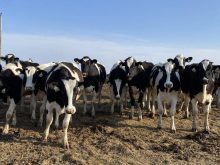When talking to producers on the Prairies about calf twins, most agree it can be a blessing if they get two live twins. However, it is a curse if the two calves are born dead.
There are also many management challenges that must be considered when dealing with twins, such as the health of the cow and the health and nourishment of the calves.
Obviously, the calves can be bulls and heifers, but there is also the freemartin phenomenon, which is essentially a sterile female. There are many ways to check if a calf is a true freemartin because probably five percent of freemartins are fertile and can be kept in breeding programs.
Read Also

Dennis Laycraft to be inducted into the Canadian Agricultural Hall of Fame
Dennis Laycraft, a champion for the beef industry, will be inducted into the Canadian Agricultural Hall of Fame this fall.
Holsteins, Charolais and Simmentals used to have the highest incidence of freemartins, sometimes as high as eight percent. I believe that has gone down somewhat over the years, especially with the British breed influence. With many breeds having black and red lines, twinning appears to have decreased.
Most producers would argue a moderate amount of twinning is OK. Calves are lost for various reasons in the spring and a living twin can be ready to be cross-adopted at a moment’s notice.
Most will cross-adopt a freemartin, especially in a purebred situation.
In all situations, record-keeping or tagging a certain way lets us recognize the freemartins so they are not inadvertently kept as replacements.
In most large groups of heifer replacements I palpate for breeding ability, freemartins are found.
The other curse of twins is malpresentation of fetuses during birth. Often, the fetuses are situated with one backward and one forward. As luck would have it, usually the first one is backward in my experience and is presented full breech, which means tail first.
We know the issue with malpresentations, especially breech births, is that the cow rarely exhibits the normal signs of labour until it is too late. Some producers will even keep a list of which cows have twinned before, knowing that cows that twin will likely twin again.
These cows throw out two eggs to be fertilized instead of one. If cows appear thinner than the rest of the herd, especially in heifers, that can be a clue they are carrying twins.
If an ultrasound exam is carried out early enough in gestation, twins can be detected. This may help in identifying a potential twin birth when the cow is first going into labour and may provide the producer with an indicator to check for a second calf during delivery.
We teach veterinary students to check for the possibility of second calf when carrying out a delivery.
If twins are delivered, check for a third calf.
Thanks to adequate nutrition and better genetics, twins are seldom the scrubs they once were. Often, two average-sized calves are born.
I know of instances in which a twin was checked for and still missed because it was too deep in the uterus. The trick here may be to gently almost shake the uterus when inside to see if you can feel weight in it. Pushing out gently on the uterus will bring the calf up or checking again a half-hour later may allow time for the contracting uterus to push the calf up.
Some producers say they have lost calves when the cow mothers up to the first calf and takes too long to push the other calf out, even when presented the right way.
If there is another water bag, it could be a sign there is a second calf present. As well, uneasiness with the cow could be another.
Twins can be easy to miss and it is frustrating when that happens. The second calf is awarded a little more time, so having the first twin a stillborn and the second alive is not unusual.
If twinning is successful, you should know the tips and tricks to graft. Skinning the dead calf of the foster cow and use of calf claim or grain over the calf are all effective.
If the calf lost was a newborn, putting the mother’s placenta on the calf to be adopted works well, but if the cow is higher strung, a good tranquilizer, such as acepromazine, will convince her to accept the new calf.
With good nutrition, I haven’t seen cows get particularly run down carrying twins and even though many are born premature (up to a week early) the former problems of retained placentas seem remote.
Saving both twins is based on the fetus presentation and the observations of an experienced operator. With breech births, sometimes the first sign is the calf’s tail sticking out the back of the cow.
Producers may need professional intervention to correct the breech depending on their experience. The goal is to look after the cow’s life.
Twins also come in different presentations, so follow the legs back to see which legs and head go with which calf. To sort out back and front legs, the first two joints bend the same way on front legs and bend the opposite way on back legs.
Another good thing to remember is that the top calf must always be delivered first. So if the bottom one is pushing up from below, it must be repelled for the top one to come out.
If twins come out alive, I never like to take the chance they both will get enough colostrum so I like to give a bag to both calves and milk the cow, or if the first calf has been up and sucked well, I will give colostrum to the second calf.
With good observational skills and giving extra TLC, we can usually be ahead on twins.
Roy Lewis works as a veterinarian in Alberta.















